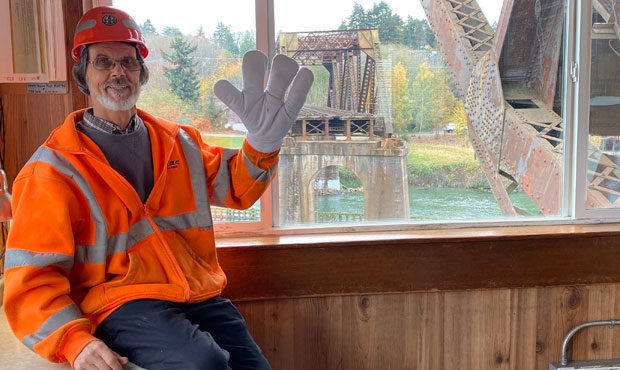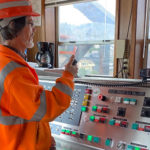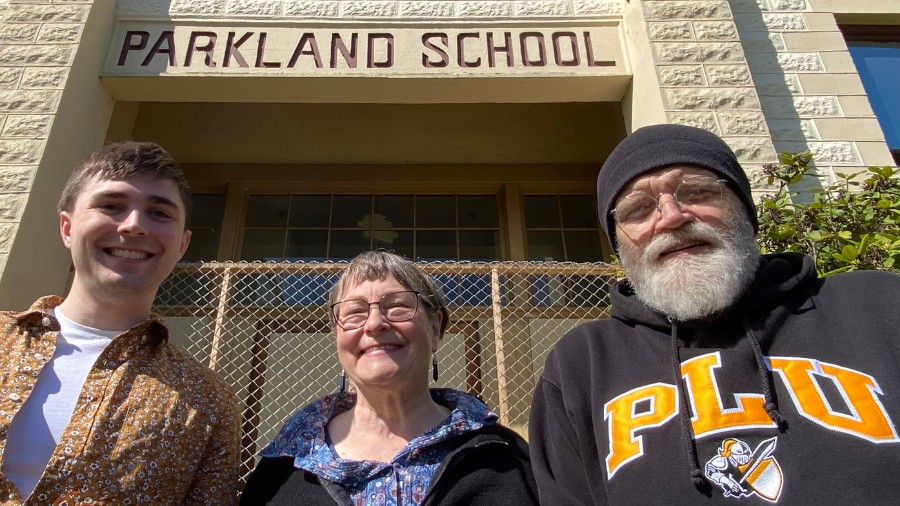Salmon Bay bridge operator keeps railroad tradition alive
Nov 11, 2020, 11:37 AM | Updated: 2:01 pm
When plans to demolish a historic railroad bridge over Salmon Bay in Ballard were changed last month by BNSF Railway, preservationists and railroad history buffs breathed a collective sigh of diesel-fumed relief.
The old bridge was built starting in 1913 and is something of an industrial relic, but remains on the job well into the 21st century. Another old-school aspect of the structure, which carries 30-40 trains a day, are the human operators who are always on duty there.
If you’ve ever been to the Ballard Locks and looked to the west, you’ve seen this distinctive railroad drawbridge with its huge million-pound concrete counterweight at one end.
The bridge was built by the Great Northern Railway 107 years ago as part of its cross-country route connecting Seattle to the Midwest and points beyond. Great Northern “descendant” BNSF Railway announced in October that rather than completely replace the beloved bridge – which would’ve been a major loss of a visual landmark – they will instead renovate it and keep the old structure looking mostly the same. A date has not yet been set for the renovation work to begin.
One part of the structure that you may not have noticed, and that’s likely to remain on the renovated bridge, is a little shack on the northeast side, situated right alongside the tracks. Inside this tiny building are the controls that move the bridge up and down, and the drawbridge operator whose job it is to manage rail traffic across the bridge, and coordinate with the marine traffic headed to and from the locks.
One of the operators who’s been on the job in the little shack for many years is Victor “Butch” Elsasser.
“I’m able to view the entire structure of the bridge trestle as it spans the Salmon Bay canal and the views of the trains coming into sight from south end,” Elsasser said by phone earlier this week from his bridge-side perch. “And I also can look north and see the trains coming from the other direction.”
Butch Elsasser grew up in Seattle. Like a lot of kids of his era, he had model trains and he liked to watch real trains going by on local tracks. When he first got a job with the railroad as a young man, he thought of it more as a stepping stone, and didn’t think it would lead to a career.
That was 46 years ago.
But speaking with Butch, it’s clear he loves his job. In the little shack, replete with a microwave, refrigerator, coffee pot, and a nearby restroom, he’s in communication by radio with the Coast Guard and with train dispatchers along the line to manage his share of the train crossings that happen each day, and the varying numbers of boats that pass underneath. The highest number of trains crossing the bridge that Butch has counted during one of his eight-hour shifts is 22.
For the trains that pass – many of which are crewed by fellow railroad workers he’s known for a long time – Butch has a special way of greeting them as they go by.
“Believe it or not, I actually have this great big white glove that looks kind of like a Mickey Mouse glove, a big white hand,” Elsasser said, describing a gift he received from his brother. “And so as they come around the bend from the south end of the bridge and they come into sight, I give them this great big wave, back and forth.”
Elsasser’s perch up in the shack on the drawbridge gives him a unique viewpoint for observing sea lions, birds – including flocks of geese that fly under the bridge – and for countless dramatic sunsets. And oftentimes, in spite of the trackside setting and the squawking radios, the operator’s shack is actually a pretty quiet place.
Of course, all of that changes when one of those many daily trains is passing by.
“The bridge itself kind of comes alive,” Elsasser said. “You get vibration of all of the tonnage on steel wheels on steel rails, and the place shakes and shimmies and there’s the clickety-clack of the steel rails on the rail joints.”
He’s also seen his fair share of windstorms and other inclement weather, including a blizzard one winter that found Elsasser out on the bridge clearing the tracks and ties with a broom when a gust of wind came up.
“It actually blew this big broom out of my hand,” Elsasser said. “And I watched it sail off towards the locks … not just over the side, but in a straight line towards the locks as it disappeared out of sight.”
The mechanism that raises and lowers the drawbridge span and counterweight is what BNSF is replacing as the major aspect of the renovation project. They did that once before about 20 years ago, but Elsasser has been around long enough to remember working on the original 1913 drawbridge mechanism. In an enclosure above the operator’s shack was a giant gearbox, with enormous gears and other machinery dating to the Woodrow Wilson administration that required intensive maintenance.
Decades later, those giant gears obviously made a lasting impression on Butch Elsasser.
“We used to go up there and grease them,” Elsasser said. “It was a two-man job. They’d have somebody run the bridge down below, and another person up above would paint grease on the gears as it was running a real slow maintenance speed.”
“Standing in there amongst all those gears was very fascinating,” Elsasser said. “I felt like a shrinking man inside a watch piece.”
Along with the animals, and the sunsets, and the boats and trains, Butch Elsasser and the other operators have a unique viewpoint for a sort of “parade of humanity” from their high perch on the old Salmon Bay bridge.
“People [are] just not aware of the bridge being up here and maybe possibly having somebody in the shack,” Elsasser said. “So I’ve seen – I’m not gonna say everything – but just about. I mean, I’ve seen a lot of activities with people.”
“I call them ‘the other side of the wildlife,’” Elsasser said, chuckling.
You can hear Feliks every Wednesday and Friday morning on Seattle’s Morning News and read more from him here. If you have a story idea, please email Feliks here.




















